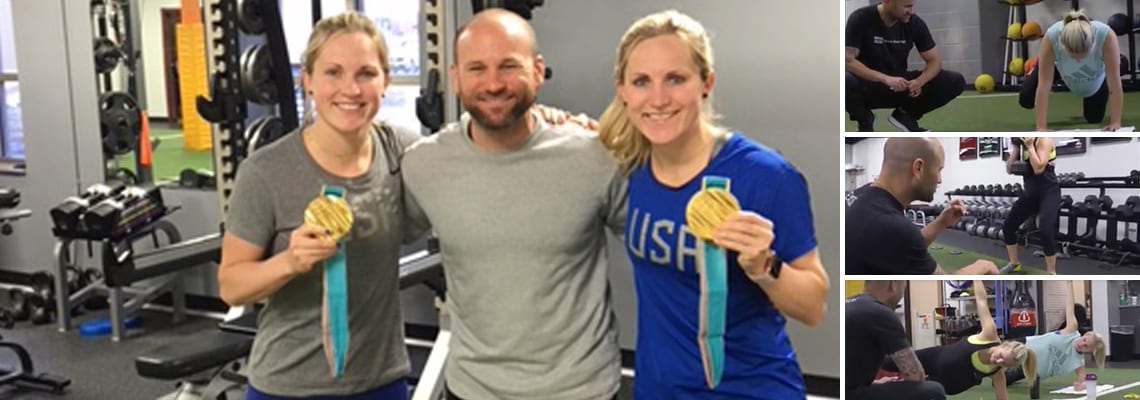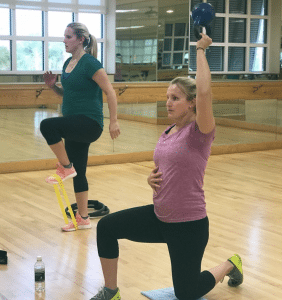
For any fitness trainer or coach, there comes a sense of pride and responsibility as you train your clients. But when you are training two pregnant gold medal Olympians and one is your wife and the other is your sister-in-law, the feeling is all the more special.
Anthony Marc Morando is married to U.S. Olympic women’s ice hockey player and gold medalist Monique Lamoureux-Morando and has been the fitness trainer to her and her twin sister and fellow teammate, Jocelyne Lamoureux-Davidson, for more than four years.
“There’s a lot of pride when you train athletes in general, but this is special because it’s my baby boy in there. Every iffy move or ‘ow’ or ‘I don’t know if I feel good today,’ you have a greater sense of urgency and your perspective is growing by the day because you realize that your responsibility is going to be forever changed,” says Morando. “I’m really excited to be a dad. I’m really, really, really excited to share all of this with my wife because she’s my best friend, and I think it’s really special that I’m going to be able to tell my kid that I took care of mommy on this end of things.”
 When it comes to pregnancy and fitness, there is often a back and forth as to what and when it is safe to work out, but as strength and conditioning trainer and manager of human performance at Altru Health System, Morando attests there’s no wrong time to start working out. More so, pregnancy is the perfect time for women of all fitness levels to start investing in their physical health through implementing a proper workout regimen.
When it comes to pregnancy and fitness, there is often a back and forth as to what and when it is safe to work out, but as strength and conditioning trainer and manager of human performance at Altru Health System, Morando attests there’s no wrong time to start working out. More so, pregnancy is the perfect time for women of all fitness levels to start investing in their physical health through implementing a proper workout regimen.
“My wife is an Olympic athlete, my sister-in-law is an Olympic athlete, and I’ve worked with so many female athletes, but athlete or not, pregnant women should train,” says Morando. “I think training makes the pregnancy process that much more special, because women can feel the physical self-perception of exercise and can reap the benefits. I don’t think enough women feel empowered during pregnancy and just feel that they are gaining weight, so they eat anything and don’t train. You have to embrace the pregnancy by taking care of yourself. You can still be fit and pregnant, and it’s a beautiful thing—I get to witness it every day.”
When it comes to prenatal fitness, Morando explains that generally there are two ends of the spectrum: someone who is really fit and becomes pregnant, and someone who is more sedentary, not as fit, and becomes pregnant. For the pregnant and fit athlete, the trick is bringing their fitness routine from the intense end of the scale back to the middle. On the other hand, for a less fit pregnant woman, the key is to help bring them from a sedentary end of the scale to the middle as well. The key is finding a safe balance of fitness either way, the only difference is having two different starting points.
“You have to create balance in both their lives. It’s not going to hurt a pregnant woman who isn’t fit to become more fit. And the weekend warrior who wants to keep pounding the rock—she needs to take it down a notch so she doesn’t compromise herself and the baby,” Morando says.
As a Manager of Human Performance, Morando reveals that regardless of a woman’s level of fitness during pregnancy, the biggest challenge is something beyond deadlifts and cardio, and is the key to successfully training them.
“The biggest challenge either way is the psychological stressors. Being able to empathize without being able to empathize,” says Morando. “I’m not a woman. I’m a 34-year-old man. I love my wife very much, but I can only put myself in her shoes so much. As a trainer, as a coach and as a husband, I have to understand that this can’t be easy. And even though I don’t completely understand, I try as hard as I can so I can know how I can provide support, not only physically but emotionally as well.”
The psychological stressors that affect pregnant women is the biggest challenge when it comes to fitness routines. Morando explains that a trainer can have all the data and game plans in the world but when it comes to pregnancy, it’s all by feel and constant communication. Upgrades and modifications are necessary in a fitness program to ensure safety and a feeling of comfortability. Whether you’re an Olympic athlete or use your at-home treadmill to sort laundry, when it comes to creating a fitness routine during pregnancy, there will be days when you just want to go for a walk or days when you can do two sets of 10 as opposed to four sets of 10. Acknowledging what the body’s needs, realizing capabilities will shift throughout the journey, and being able to adapt to the psychological stressors that arise during pregnancy are essential in order to achieve the optimal training solutions.
During pregnancy, the female body undergoes a variety of remarkable biological and physical changes that can affect the psyche and fitness performance. Keeping in tune to the body’s needs and making proper modifications when it comes to specific exercises is key to ensuring that no harm is done.
While psychological factors are an obvious difference from pre-pregnancy to pregnancy, overall, when it comes to physical training, Morando is striving to break the molds of male and female fitness perception.
“There are always differences when it comes to gender, in particular hormonal differences, especially during pregnancy. At the end of the day, though, the only difference in a female is that her hip circumference may differ a tad so she is more at risk for a knee injury. Aside from that, men and women should train the same. You train them like men and treat them like women,” says Morando. “Now when it comes to pregnancy, the first rule of thumb is to do no harm, so there are moves that you do avoid.”
When it comes to Morando’s training techniques for his wife and sister-in-law, the athletic mindset has shifted. For these two Olympians who typically train for a game day that involves a gold medal in February, their game day now is labor. Preparing for this event means tightening the abdominal muscles, initiating stabilization of the spine, and practicing a lot of exhalations.
Pregnancy Fitness Tips from Anthony Marc Morando
Exercise to Avoid: Crunches
“No pregnant woman needs to crunch. Personally, I think crunches are outdated to begin with because our spine flexes way too much, but pregnant women are prone to splits down the middle of their stomach, so the best way to avoid that is to not flex the stomach. Instead, we want to stabilize the musculature around the amniotic sac that is going to surround the baby.”
Alternative Option: Planks
“We want to create strong stabilizers. Your abdomen is meant to store, transfer and brace when it comes to energy, so we don’t want to flex and extend the spine. Instead, we want to plank, and we want to put pregnant women in standing positions to make sure we don’t compromise their pelvis or the baby.
We make sure things stay tight. We want to maintain stiffness in the torso because bracing and stability is what labor is. Bracing and stability is going to give them a chance to have a better labor because they will have the chance to strengthen the diaphragm, which will need to expand and recoil every time they push.”
Exercise to Avoid: Plyometrics (Dynamic and Explosive Movements)
 “Plyometrics are not necessary for a pregnant woman. Explosive movements, excessive jumping and anything that requires holding of the breath before a movement aren’t needed. If they do have to jump, it should be minimal, but once you get into your second and third trimester you don’t want to rattle the cage. I personally say avoid plyometrics.”
“Plyometrics are not necessary for a pregnant woman. Explosive movements, excessive jumping and anything that requires holding of the breath before a movement aren’t needed. If they do have to jump, it should be minimal, but once you get into your second and third trimester you don’t want to rattle the cage. I personally say avoid plyometrics.”
Alternative Option: Static and Stationary Movements
“Some type of stationary movement is best. To avoid pregnant women from doing a squat jump, just have them do a squat. It’s about static versus dynamic. We want to minimize excessive dynamic and explosive movement, and we want to substitute that with static strengthening with things like a body weight squat and body weight split squat—exercises that will keep them safe and that are going to create a healthy foundational form of strength.”
Exercise to Avoid: Intense Conditioning – Especially Burpees
View this post on Instagram
“You want to avoid movements that involve getting up and down quickly. I can’t stand burpees. I think it’s probably one of the worst exercises ever given. It’s degrading to the body because of how much damage it can do. The bigger the belly gets, the more awkward the movement becomes, and mom is going to get frustrated if things feel awkward. You can do a lot of other exercises to increase the heart rate moderately and give them the feel of what a burpee would be like without flexing the spine and potentially damaging their hips.
For general cardio, you want to avoid excessive intervals and high intensity. When it comes to cardiovascular work, rate perceived exertion (RPE) with pregnant women should not go above an eight out of ten.”
Alternative Option: Hip Flexions, Marching in Place and Non-Frictional Machines
“A good alternative to intense cardio that we do is prone hip flexion or a push-up to hip flexion. This is done in a push-up position and includes bringing the knee to the chest. Other things you can do are march in place for 30 seconds or slamming a medicine ball. Basically, moves that require either a standing position or where the hands are elevated so the spine and hips aren’t compromised.
If you really want to feel that burn, then that’s where exercise bikes, versa climbers and non-frictional machinery come in.
Steady state cardiovascular work where you are building a general base of fitness is key. With the girls, they will do some intervals of a hard 10 to 15 seconds, but they don’t exceed that and they immediately have a 30 to 60 second rest afterward before another interval, so they have plenty of rest time in between. Even during these intervals, though, they never exceed 80 percent on the RPE scale.”
Exercise to Avoid: Intense Stretching
“Pregnant women are undergoing many hormonal changes and they are full of relaxin [a hormone secreted during pregnancy to prepare the uterus for labor]. Also, they are already getting stretched, so it’s pretty easy to overstretch. We don’t want to give them a potential cause for injury.”
Alternative Option: Foam Rolling
“To wind down, while we tend to do more core strengthening and shoulder strengthening, we also do some foam rolling to continue blood flow and to create a quality fascia line [connective tissue structures between muscles]or better quality of movement in the muscle.
We also do a steady cardiovascular cooldown—what I call a flush—anywhere between five to seven minutes of low level, steady state cardiovascular work, where their heart rate is at a minimal intensity.”
Exercise to Avoid: Supine Positions
“We don’t want to put pregnant women in a supine [laying on the back] position, especially as they get further into their second and third trimesters.”
Alternative Option: Standing Exercises
“Sitting and standing are best. Standing is great because you can do so much from a standing position. Pregnant women can squat. Pregnant women can do high surface deadlifts. They can also get core work standing and carrying something. If they breathe normally, they will feel well and the best position for that is when they’re standing up.
Balance is another deal. One leg holds, unilateral holds, holding for three sets of 10 seconds, or one longer 30 second hold all work great. And if you feel wobbly during these, then hold something for support, but remain on one leg to build stability.
You can also stick to squatting and assisted squat patterns. Hinging, which is another form of deadlifting, can be done by lifting from a high supported surface so the lower back isn’t compromised. Pushing can also be done. Push-ups are fine but because of the extra weight and growing stomach, they may not be able to do it from the floor, so you elevate their hands to a high surface such as a barbell or a bench and have them touch their chest. They can also do exercises that require a pull, not necessarily a pull-up but a standing band pull or pulling a band apart to activate the shoulders, a standing pull-down, or standing rows. Most all pregnancy-safe exercises come from standing and seated positions.”
As Morando continues to strive to educate women that pregnancy is the perfect time to strive for a healthy body, he gets closer and closer to adding a new title to his list of accomplishments: coach, trainer, husband and soon, dad. Until then, he continues to train his Olympian family during their pregnancies.
“They do a really good job with knowing their limits. They are, obviously, very good athletes, but they are smart women too and they understand training. And sometimes you just have to bring them back every now and then. So, if I know Monique hasn’t been sleeping very well, then instead of banging it out at the gym, if she wants to get a good sweat in, then maybe it’s just a matter of putting on a sweatshirt and going for a nice two-mile walk. If you try to push through even a moderate workout when you aren’t on a good foundation, you’re not going to recover and you’re not going to gain longevity,” says Morando. “You’ve got to gauge it, you’ve got to communicate and every now and then you’ve got to say ‘no’ to your wife.”

Anthony Marc Morando graduated from Springfield College with a bachelor’s degree in applied exercise science. He is a certified strength and conditioning specialist and holds certifications from the Collegiate Strength and Conditioning Coaches Association and in functional movement systems, TRX and CFSC. He is the former strength and conditioning coach for the men’s and women’s hockey programs at the University of Minnesota Duluth and the men’s hockey program at Boston University. He is currently the manager of human performance at Altru Health System, powered by EXOS.


